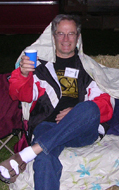- Details
-
Created: Monday, 02 March 2009 03:44
A recent project I did this past summer through Path with Art, an organization which works with people in transitional housing, returned me to teaching after some time off. While the exhibit was vandalized before the scheduled month was out, it did last two weeks, and the participants were alright with letting go of their projects in order to have them seen.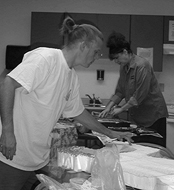
The "doing" of the pieces was tremendous for all who participated in the course, and valuable skills were learned (mixing concrete) or relearned (making templates). Actually, we regressed all the way to kindergarten ("Hey, this is fun!), cutting shapes out of construction paper. Every one of the original twelve students "in recovery" could do that. Then many of the original students whipped through my curriculum on 3-D design in just 6 sessions, culminating in the public exhibit of our work. (I did have to put in some time between sessions.) Here are some notes of mine from class:
Everyone who was present was ready to work. We discussed the "Chief Seattle" public art work down on 1st and James and then spent a little time brainstorming about using written greetings on the sculptures (how've you been, how're you doing, what's up). At the end of the day though, the students thought that our final artwork would speak for itself simply by being expressive.
The group of six was about right for the day's final project, tracing each other's outlines onto butcher paper. These were then cut out and arranged. Two were taped together, as though the "cartoon" people were high-fiving each other, and this set off a round of actual greetings among the students, including a couple of hugs. Fostering "connections" between the students is an important goal.
Good thing I am writing this update, as I just found an overripe banana in my class satchel. I was using it to draw on with a dark marker, in order to demonstrate cross contour lines. Earlier that day, the students were asked to draw a round form (apple) and a square form (block of Styrofoam), each wrapped in string, like a holiday present. The assignment was to draw the string only, which in turn would define the object (sphere or cube). I went around and helped everyone succeed at this. Students have expressed that the class is changing how they "see."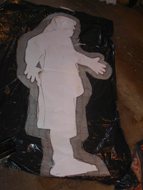
Students then drew and traced a portrait of a woman by Picasso, done in simple line and cross-hatch, with a strong 3-D presence. We also looked at magazine pictures and discussed the possibility of producing portraits, or complete bodies, in Styrofoam. So far the class is accepting some steering by me (towards a figurative work in Styrofoam) but adding lots of ideas (working in teams, adding sand to paint for texture etc etc). I brought in samples of three grades of Styrofoam to pass around, and we discussed the budget constraints and possibilities. We did stay on budget.
Each student chose a magazine portrait from a selection I brought in order to draw and trace from it. Looking at magazine pictures of complete bodies of models with "attitude" led to the tracing of each other's silhouettes on the wall. For now these have been wrapped and stored. They may be the final templates, and maybe not. (Note: they were.) Students are now more familiar with terms such as outline, axes, silhouette, posture, and gesture, as well as cross sections defining both volume and mass. We are moving very fast through curriculum.
Next week we will work on composition, proportion, and scale, and we may produce more outlines. Then I will start cutting them out in Styrofoam to bring in and "finish" with paint and texture. I have priced the cement blocks, and premix, and will probably donate the rebar and paint from my studio stocks.
We ended with a "unity circle" where each participant came up with a word to describe what they felt they were bringing to the project. The words were: "peaceful, discovery or curious, triumphant or victory, peace, tenacity, laughter, and attitude."
One student said that the artwork should say: "We were where you were, but we're free." Participants are well aware that the site (the park at 4th and Jefferson) is "where they sell drugs". Another has seen prostitution there. Another goes to feed the birds. We all agree that existing park signage is all about what you may not do in the park. There is no sign for "Picnic in peace."
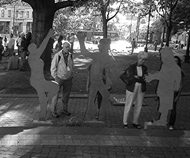
End of notes.
Ultimately the group settled on a theme and title of "Hope" for the completed figures. Getting them ready for the install came down to a team of three plus a staff person, and when I asked for a definite commitment from them to wheel the figures to the park, I got a firm "We're all in this together!"
I heard about Path with Art through the mailing list for the Henry Gallery in Seattle. I had completed docent training there in spring 2007, and then decided not to serve as a docent as I do not actually appreciate contemporary art in general. However, a mention of a tour by a Path with Art group inspired me to look up their website and to apply to be a sculpture teacher again. I modified curriculum from a class on 3-D design which I used to teach here in Seattle at Pratt Fine Arts. Elaine has accepted yet another modification of it as a "workshop" for NWSSA at Camp Brotherhood for the coming summer (Tues, Wed, Thurs). We’ll do hands-on individual projects to understand concepts of 3-D design as applicable to sculpture in many media. Bring good scissors!
- Details
-
Created: Thursday, 01 January 2009 17:06
In October of 2007, my brother and I collected the rhyolite from an ancient volcanic ridge 50 miles east of Reno. I liked the “desert varnish” on one side and the patchwork of colors on the other. Months later I decided to create a right leaning torso on one side, leaving the sun-varnished back side untouched.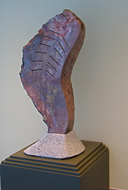
This last July at Camp Brotherhood, with the help of Ken Barnes and Tom Francis, I began the work, choosing a large granodiorite cobble for a base.
In October my son-in-law David True, who had recently undergone back surgery at Seattle’s Swedish Orthopedic Institute, told me that he wished to donate the piece to the Institute’s permanent art collection.
Enthusiastic about his idea and guided by his anatomical expertise, I created the ribs with chainsaw plunge cuts. All was ready by the second week of December. Verena Schwippert and Kirk McLean loaned me their modified engine hoist and Al Mangold devised a way to use it as a transport platform from the studio to the hospital’s third floor family-conference area.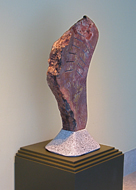
So, fourteen months after its discovery on that volcanic ridge, and with the much appreciated help from a few NWSSA friends, ‘Flexion II‘ now stands as a vivid and visible example of the human body’s abilities to work and to heal.
